 Seek veterinary care IMMEDIATELY if:
Seek veterinary care IMMEDIATELY if:
- Your cat appears to be straining to urinate in the litter box (or outside it) but being unproductive
- They vocalize (cry, meow, howl) when attempting to urinate
- They are making frequent visits to the litter box but only produce a small amount or no urine
- They have blood present in their urine
- They are suddenly urinating outside the litter box
Your cat may have a urethral obstruction (UO), and this is a severe, acute, and critical medical emergency. Death can occur without prompt and appropriate treatment.
Stop reading this article and get to an emergency veterinary hospital right away. Come back later to learn how to care for your cat post-treatment and how to prevent this from happening again.
If you have a cat, particularly a male cat, it is critical that you know all there is to know about feline urethral obstructions.
In this article, I'll cover what you need to know so that you can recognize and be prepared in the event of a urinary tract obstruction. Additionally, there is information on how to prevent urethral blockages.
Skip to section:
What Is a Urethra, and What Does It Do?
Your cat’s urinary system is much like yours. It includes kidneys, ureters, a bladder, and a urethra.
Most people know what the kidneys are and what the bladder is, but not many are familiar with the urethra (or its tubular cohorts, the ureters). The ureters are the tubes that connect the kidneys to the bladder. The urethra is the tube connected to the bladder through which urine leaves the body.

Here is an analogy that may help you understand how this all works. If the bladder is a warehouse where a ‘product’ is stored (in this case, urine), and the litter box is the customer that this ‘product’ needs to get to, the urethra is the interstate that UPS or FedEx depends upon to deliver said ‘product’ to its final destination. If that interstate becomes impassable, for whatever reason, the product can’t be delivered to its final destination.
While the scenario above will certainly prove to be a hassle to both the manufacturer and the customer, it isn’t likely to result in the death of either.
In the case of a urethral obstruction, though, if the urine cannot be delivered to its final destination — the litter box — a dangerous build-up of electrolytes and metabolic by-products will result, and multiple organ systems will fail.
The heart is of utmost importance among those organ systems. The build-up of potassium and other substances will prevent the heart from pumping, leading to cardiac arrest and death.
It is absolutely critical that a cat that cannot pee receives appropriate veterinary medical care immediately. With prompt medical care, the survival rate for a cat is higher than 90%.
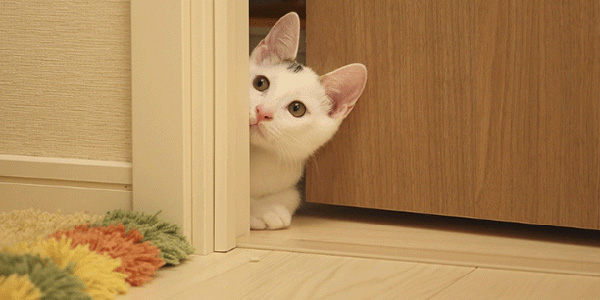
How Does a Urethra Become Obstructed?
It may surprise you, but there are a variety of mechanisms by which a cat’s urethra can become obstructed.
Ways a Cat’s Urethra Can Become Blocked
- The formation and lodging of a urinary mineral stone (‘urolith’)
- The formation and lodging of urinary ‘sand’/’grit,’ or a plug of mucus secreted from an inflamed bladder wall or urethral lining
- The formation of a blood clot resulting from bleeding within the urinary tract
- The presence of a tumor (cancerous or not) arising either from within the urethra itself or from a structure surrounding the urethra that compresses it from the outside
- The development of scar tissue within the muscle that surrounds the urethra is a urethral stricture; it narrows the diameter of the urethral lumen through which urine can pass, potentially resulting in an obstruction.
- Spasms of the urethral muscle can have a similar result on the urethral lumen diameter as a urethral stricture.
Which Cats Are at Risk of Urine Blockage?
Though all cats (and dogs) are at risk of urethral obstruction, the condition tends to happen most often in cats with certain other predisposing factors.
Predisposing factors for urinary blockage include:
Cats of any age can be affected, but most cats are young to middle-aged (between 2 and 6 years of age).Our survey of 4,204 respondents revealed the following data relating to the age of the first (or only) occurrence of a urinary blockage:
- 1–4 years old = 50.57% (2,126)
- 4–7 years old = 28.59% (1,202)
- 7–10 years old = 13.61% (572)
- older than 10 years old = 7.23% (304)
Male cats are at higher risk than female cats since they have a longer urethra. The data we collected from our survey of cats affected with urethral obstructions indicated that 69.3% of them were male.
Overweight cats are at greater risk than cats of good body condition.
Cats that eat only (or even predominantly) dry food are at greater risk than those that eat exclusively (or predominantly) wet food.
Cats that previously had a urethral obstruction are at increased risk of obstructing again — especially if management and preventive measures haven't been implemented since their first obstruction). See below for ways to prevent urinary blockage.
Cats with recurrent bouts of bladder inflammation (cystitis) are at increased risk of developing a urethral obstruction.
Stressful situations (e.g., home renovations, family trips, a new baby, multi-cat households, etc.) or cats that are typically nervous or anxious are at an increased risk of urethral obstruction. Know what signs of stress to look out for and read this article by board-certified veterinary behaviorist Dr. Chris Pachel on the causes and prevention of cat stress.
Neutered cats and indoor-only cats also appear to be at greater risk than sexually intact cats and those who spend time outdoors.
However, both of these factors also tend to predispose cats to obesity — mostly because people overfeed them relative to the amount of calories they actually need — and, therefore, these are more likely indirect risk factors for the development of urethral obstruction (because of obesity).
And since having cats neutered and keeping them indoors has far more health and safety benefits than the relatively small increase in risk they may have in relation to the development of a urethral obstruction, I still recommend that you do both and focus on changing the other even more important urethral obstruction risk factors.
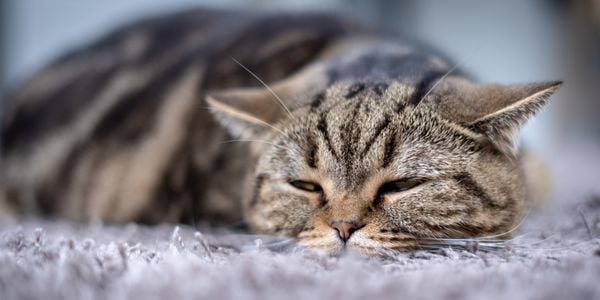
Symptoms of Feline Urethral Obstruction
If you know or suspect your cat can't pee, the signs and symptoms your cat is likely to have when there is a urinary blockage will, in part, depend on how long they’ve been obstructed.
As with many conditions, the earlier you recognize it and appropriately act upon it, the better your cat’s chances for survival are and the lower your financial costs will typically be. See below for veterinary costs to treat this condition.
If you pay close attention to your cat’s energy level, appetite, eliminations, and behavior on a daily basis — you will be more likely to catch a problem earlier. In cases of urethral obstruction, a cat can die if they’re obstructed in as little as 24 hours and potentially less.
Signs That May Indicate Urethral Obstruction in Cats
- frequent trips to the litter box
- lack of urine in the litter box after you know they’ve been in there
- vocalizing or straining while in the litter box (many owners mistake this for a sign of constipation – see the slight difference in posture in the illustration below)
- excessively licking of their genital area
- loss of appetite
- sudden onset excessive drinking
- vomiting
- abdominal pain (often expressed by them trying to bite or scratch you when you try to pick them up)
- hiding
- collapse
- death
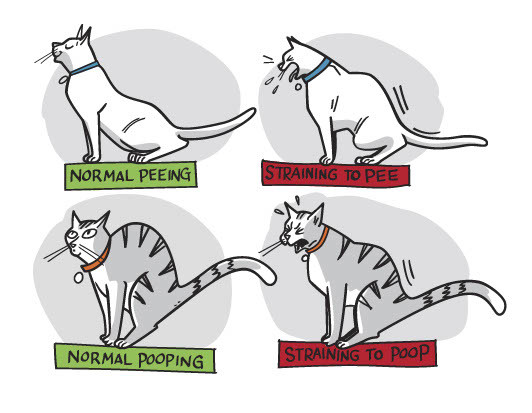
If you notice any of these signs in your cat — especially if they are male, have a history of urinary tract issues, or have any of the other predisposing factors — take them in for immediate veterinary medical evaluation and treatment.
This is not a trivial condition, and it is certainly not one to ‘wait until your vet’s office opens in the morning or after the weekend.’ Go to the emergency hospital right away.
Even if it's not a urethral obstruction, it's always better to err on the side of caution.
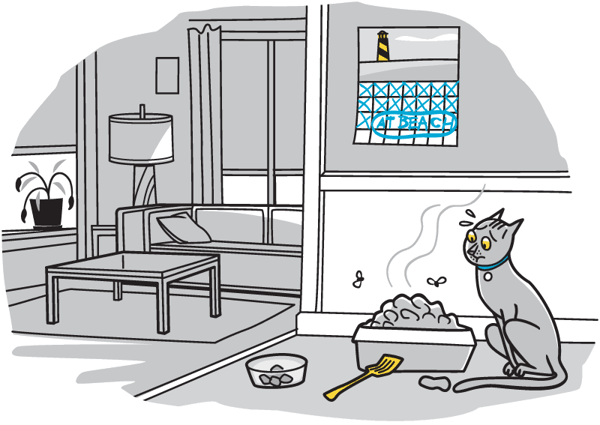
If You Travel and Leave Your Cat Behind
Make sure to have someone checking in on your cat(s) at least once daily any time you’re traveling. This is a very common time for urethral obstructions (and a variety of other stress-related cat emergencies) to occur.
Inform your sitters of the signs of urethral obstruction and that they should not take a 'wait and see' approach. Cats also have become obstructed after their family returns due to the stress of the change in their routine.
A cat can die if they’re obstructed in as little as 24 hours – potentially less.
The video below is from when our team member's cat, Mazel, was recovering from a urethral obstruction and was still showing signs of straining while peeing. When he first was experiencing symptoms, he became very vocal and would yowl. His eyes would also get wide with pain.
A cat who displays these symptoms needs to be seen by a vet immediately. It is a matter of life and death. Thankfully, Mazel recovered well after a few nights in the veterinary ER.
Treatment for Urethral Obstruction
First of all, there are no safe and effective first aid steps that you can or should perform at home for a blocked cat. DO NOT attempt to express their bladder yourself. You may cause it to rupture, which can lead to severe complications.
For your cat to survive, they must receive appropriate medical treatment immediately.
Because this condition is painful, you may be inclined to give your cat some pain medication. DON’T!
There are very few pain medications that can be safely used in cats even under the best of circumstances — and a cat with a urethral obstruction is far from the ‘best of’ circumstances.
By giving your cat a pain medication from your medicine cabinet, you will worsen their problem as well as significantly increase your cat’s chances of death.
If your regular veterinarian is open and they have staff present overnight to care for hospitalized patients, I recommend going there as they are familiar with your cat’s history and can initiate care immediately.
However, if your regular veterinarian doesn’t offer after-hours care (a person present at the facility all night), I recommend going to a 24-hour emergency hospital so that you won’t have to transport your pet in the middle of treatment.
When treating a cat with a urethral obstruction, the veterinarian will ensure that your cat's heart isn’t at risk of failure due to the toxic metabolic imbalances created by the blockage, and they will stabilize the situation if it is.
As you might imagine, this is a vitally important step if a cat is to survive their obstruction, and it's one of the reasons why ‘blocked’ cats are rushed straight back to the treatment area if they’re deemed unstable on initial triage.
Once the initial assessment is made, necessary medications to stabilize your cat will be administered based on physical exam findings and diagnostic tests. An IV catheter will be placed, and essential monitoring will be initiated.
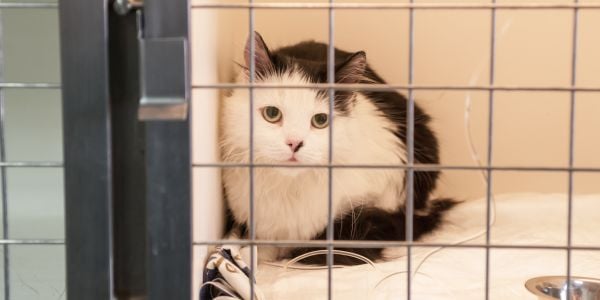
Once your cat’s cardiac function is protected (or restored), the work to correct their metabolic imbalances and relieve their urethral obstruction can begin. This usually involves the ongoing administration of intravenous fluids and sedation or anesthesia to facilitate the placement of a urethral catheter to restore the flow of urine and allow for flushing of the urinary bladder.
In most instances, this urinary catheter will be left in place for anywhere from 24 to 72 hours, with the actual duration depending upon many factors. The catheter is sutured into place and then usually attached to a closed collection system. (A closed system consists of tubing that connects the urethral catheter to a collection bag.)
This prevents the introduction of bacteria into the bladder from the released urine and facilitates measurement of the quantity of urine produced, which helps to determine if the rate at which the IV fluids being administered need to be adjusted.
Some combination of X-rays, blood tests, and urine testing are frequently part of the workup for blocked cats as well. These tests can help discover bladder stones, electrolyte abnormalities, kidney damage, and possible infections that may be present.
Treatments, in addition to intravenous fluid administration and pain medication, are often medications to relax the urethral muscle. Additional diagnostics and/or treatments may also be necessary in some cases. Close monitoring of your cat’s hydration, vital signs, appetite, blood parameters, and comfort is also vitally important.
Note: The drug Prazosin has been commonly used to prevent recurrent urethral obstruction, which affects 11% to 58% of cats. It was used because the medication acts as a urethral muscle relaxant, which would reduce the risk of recurrence.
However, a study was conducted to determine if the administration of prazosin actually decreased the risk of reoccurrence of urethral obstruction. The data collected from this study and other studies showed that cats given prazosin were more likely to develop recurrent urethral obstruction.
Therefore, it is not recommended that prazosin be used routinely in order to prevent recurrent urethral obstruction.
Special note: All cats with indwelling urinary catheters and those on intravenous fluids should remain in the hospital for close observation, as many complications can occur with either.
If your veterinarian’s office does not have a staff member present overnight to monitor your cat with a urinary catheter and IV fluids, then you should transfer your cat to a local emergency hospital for overnight monitoring. The importance of this level of monitoring really cannot be stressed enough.
If there are no local emergency hospitals for you to transfer to, and your regular veterinarian does not have overnight monitoring, then your cat may be better off having their urinary catheter and IV line pulled and sent home with you for monitoring. Be sure to discuss this carefully with your veterinarian.
Monitoring Your Cat at Home
When monitoring your cat at home, it is essential to follow every detail of your veterinarian’s instructions. You MUST be sure that your cat actually urinates when attempting to, give medications exactly as directed, and provide fluids, either orally or subcutaneously (under the skin), throughout the night.
Even if your cat seems to do well overnight, do not leave them home alone the next day. Either continue monitoring them at home if your veterinarian feels it is okay or bring them back to the veterinary hospital for continued observation.
Follow-Up Treatment for Feline Urethral Obstruction
When the time comes to pull the urinary catheter from your cat, it is important to monitor your cat closely. Following the removal of the catheter, it’s not uncommon for cats to re-obstruct.
If a cat re-obstructs when their catheter is removed, they will need to be sedated again to have another urethral catheter placed, and the process of care starts all over again. This condition is frustrating and complicated to treat, and there is no way to predict which cats will re-obstruct, nor is there any way to predict how quickly cats will regain their ability to urinate normally.
The presence of a ‘foreign body’ — such as a previously placed, but not fully removed, urethral catheter is but one of the reasons why cats with indwelling urethral catheters must always wear E-collars (cones) and why they should never be left overnight alone at home or in the hospital without on-site supervision.
Perineal Urethrostomy Surgery
For male cats that block 3 times within a short time span or those that are discovered to have a stricture (abnormal narrowing) within a certain part of their urethra, a surgical procedure called a ‘perineal urethrostomy’ (PU) may be recommended.
During a PU surgery, the penis and its narrow portion of the urethra are removed, and the lining of the wider portion of the urethra is sutured to the skin, creating a wider opening and making the cat’s external genitalia more similar to that of a female cat.
This procedure can greatly reduce the chances of a future obstructive event if done correctly, and there are no post-operative complications (infection or compromise/opening of the surgical area).
This procedure is not without its complications and can be expensive, so it's not typically recommended until a cat has clearly demonstrated (repeatedly blocking despite preventative measures) that they would benefit from having it performed.
The long-term quality of life for cats was evaluated by this retrospective study.
How Much Does It Cost to Have a Urethral Obstruction Treated?
The final costs for treatment of a case of urethral obstruction in a cat will be influenced by many factors, including:
- How long the cat was blocked and how sick they were on arrival at the hospital
- Whether or not they require surgery to correct the blockage (such as to remove a stone) or prevent a future blockage (such as the PU surgery described above)
- Whether or not they re-obstruct upon removal of the indwelling urethral catheter
- The diagnostic tests and therapeutic treatments necessary in their care
- The duration of their hospital stay
- The type of hospital in which they receive their care (costs at general practices are typically lower than those at specialty or emergency hospitals, though there may be more transferring back and forth for overnight monitoring with the general practice)
- Your geographic location and other factors
Typically, treatment for a non-surgical case of feline urethral obstruction that doesn’t re-obstruct when the catheter is pulled will likely cost between $750–$1,500.
However, for cats that obstruct multiple times or those that require surgery as part of their treatment, you should expect the costs to be between $3,000 and $4,500 (possibly more).
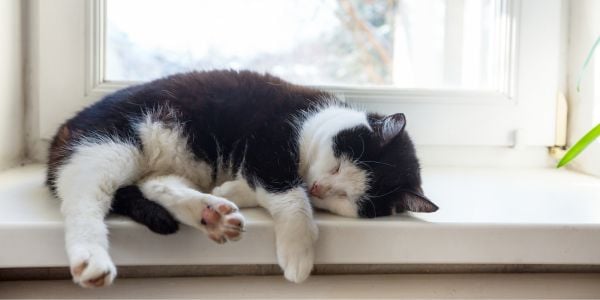
Preventing Urinary Obstruction in Cats
While it's not possible to guarantee that you’ll never have to deal with a case of urethral obstruction, I can say that the changes below will greatly decrease the likelihood of your cat blocking, and every little bit of prevention really does help!
Dilution Is Part of the Solution
When it comes to the health of your cat’s urinary system, hydration to cause dilution is essential!
Minerals within the urine can unite to form crystals, grit, and stones, any of which can lead to a urethral obstruction. As for the inflammatory mediators (a group of molecules such as histamines, cytokines, or prostaglandins), they can lead to bladder wall inflammation (cystitis), which itself is another of the risk factors for urethral obstruction.
The more water (moisture) going into your cat, the less concentrated their urine will be (both with minerals and inflammatory mediators), and the more regularly they will urinate and flush out their bladder.
By improving your cat’s hydration (or at least preventing their dehydration), you can decrease their risk for urethral obstruction.
How to Improve Your Cat’s Hydration
If you're not sure how much water your cat needs, we have a calculator to help you.
Measure the water (in ounces or cups) when you clean and refill their water bowls each day. Keep a log so that you can monitor your cat's drinking trends.
In addition to water intake, there are other ways your cat gets hydration, and if they aren't drinking enough, there are ways to entice them.
Feed canned food
The greater the proportion of your cat’s diet that comes from canned food, the greater the amount of water they will naturally consume on a daily basis. Most canned diets are somewhere in the neighborhood of 70–80% moisture, whereas dry diets are often 10% or less.
So, while your cat will be eating their necessary daily calories for survival, they’ll also be taking in plenty of water if they're eating canned food.
Canned foods offer other health benefits to cats as well, particularly in relation to weight management and the prevention/correction of obesity and diabetes
It should also be noted at this point that, although I am a veterinarian, each cat’s health history and specific dietary needs and restrictions can differ; therefore, I would always recommend that you discuss all the diet decisions and changes that you plan to make for your cat with your veterinarian prior to doing so.
Multiple water sources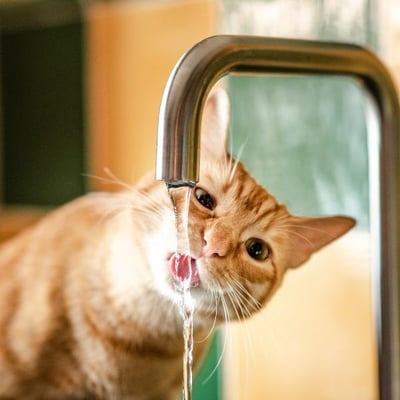
Have multiple water dishes available throughout your home. The easier it is for your cats to get clean, fresh drinking water, the more likely they are to drink it.
Having water bowls in multiple rooms and on several different levels (if applicable) is a great way to help ensure easy access.
It's also a good idea to have bowls of different materials (metal, glass, ceramic, etc.), depths, widths, and shapes when possible. Cats can be ‘finicky,’ so it's all about making it easy and attractive for them to drink water.
Water fountains often entice cats to drink more. These can be particularly effective (and my top choice) for cats, especially for those who like to drink from faucets or bathtubs.
See our fountain and water bowl recommendations here.
Offer water at varying temperatures
Just as people prefer to drink water at different temperatures, so might your cat. Experiment with water at different temperatures (cold, cool, room temp, slightly warm) to see what your cat prefers. While this may take a little extra work, it is way easier and cheaper than having your cat treated for recurrent urethral obstructions.
Use ‘special water'
The product CATWATER was formulated to be mineral-free and pH-balanced to help prevent urinary issues. It has been clinically proven to decrease minerals in the urinary tract by up to 50%.
Note: It is NOT recommended to use distilled or demineralized water as those types of water have a pH level of 6, which is too low for cats. The perfect pH balance for cats is between 6.2 and 6.4.
Flavor your cat’s water
This can be a great way to encourage more water intake. You can use some low-sodium chicken or beef broth (be sure it doesn’t contain onions or garlic, as they are toxic). This bone broth powder is safe for pets and easy to use.
Probably the most enticing additive is the water from a can of tuna (tuna in water, NOT oil). A simple way to get the most out of the water from a can of tuna is to dilute it with more water, then fill an ice cube tray with the mixture and freeze. (Be sure to label this tray, though… few people will want a tuna-flavored ice cube in their own drink.) Drop one of these ice cubes in your cat’s water dish at each change, and voila… tuna-flavored water!
You can also try using Purina’s specially formulated, nutrient-enriched, liver-flavored Hydra Care water supplement that has been shown to increase water intake and promote hydration.
Here's our article on tips, tricks, and products to help you get your cat to drink more water.
Stress Management for Cats
Stress can be a major contributor to the development of feline urethral obstruction (and a host of other medical problems as well).
Signs of stress can arise from a change in the weather (cases of urethral obstruction seem to increase in frequency during cold snaps), a new addition to the family (human or animal), a change in household dynamic (holiday visitors, family traveling, home renovations, and others), or poor litter box management — just to name a few.
In many cases, you can take simple steps to minimize your cat’s stress and decrease their risk of developing a urethral obstruction.
Practice good litter box maintenance
Our survey about urethral obstructions revealed that 42.79% of the respondents only had one litter box. The general ‘rule of thumb’ in the veterinary world is to have one more litter box than the number of cats you have (e.g., 2 boxes for 1 cat, 3 boxes for 2 cats, and so on).
Having the boxes in different rooms, on different levels of the house, and away from high-traffic areas of the home can help, too.
The frequency with which you will need to scoop and clean the boxes will depend on how fussy your cats are, but it's best to err on the side of caution and scoop daily and do a full clean regularly (weekly is ideal). Read more on cleaning litter boxes.
The type of box and litter can have an impact as well, with most cats preferring large, uncovered litter boxes and unscented, dust-free litters — but every cat is different, so try out several to determine your cat’s preferences.
This small investment in time can yield significant benefits.
Here's everything you need to know about litter boxes and cats, including how to choose the best litter and litter boxes and where to put your cat's litter box.
Cats are NOT party animals
Most cats really don’t like changes in their daily routine, and few things change up that routine, quite like the holidays and overnight visitors. When the holidays come, be sure to provide your cats with their own ‘safe room,’ complete with a clean litter box (or two), fresh water and food, and some comfy bedding.
Keep this room off-limits to visitors, and your cats will likely weather the holiday storm much better. A ‘safe room’ is something that some cats may need all year, especially when introducing a new pet or baby to the family or remodeling your home.
Don’t forget playtime
Though some cats might not seek out playtime with you, many would eagerly jump at the chance if offered, and it can be a great way to decrease stress — theirs and yours!
Cat play isn’t as time-consuming as you might initially think, but there is a way to make it as efficient and beneficial as possible. Mimicking how cats hunt and using the prey sequence is the best way to play with your cat.
We break it all down into 4 easy steps in this prey sequence article. And since playtime will also help with your cat’s weight control, it has a double benefit when it comes to preventing urethral obstructions.
Grooming
Just because cats are self-groomers doesn't mean they can't benefit from some special attention. Petting and brushing their coat can help to decrease their stress.
The power of pheromones
Pheromones are compounds that animals naturally secrete to elicit a certain type of response from another member of their species. In the case of cats, calming and anti-anxiety pheromones have been isolated and synthetically reproduced and are available in a product called Feliway. It comes in both spray form (great to spray on bedding) and as a plug-in diffuser.
It can go a long way towards decreasing stress and anxiety in cats when used appropriately. Such pheromones can also be helpful when introducing new cats or when trying to decrease in-fighting amongst cats within the same household.
Note: When first sprayed, the product can have an alcohol-like smell. If you spray in a room or on bedding, wait about 15 to 30 minutes before allowing your cat in the area or giving the bedding back. No smell is generally noted with a diffuser.
Treats, please
Treats are great, but they are even better when they provide the additional benefit of calming without a sedating effect. Specially formulated treats contain natural calming ingredients, and another great thing about calming treats is that cats readily (well, most!) eat them whole or crumbled on their food, and you don’t have to pill them.
For easily stressed or anxious cats, try giving them treats such as VetriScience Composure Calming Formula or Nutramax Solliquin to help ease their nervousness.
Let your cat have a sleepover
It's not uncommon for cats to get into a whole heap of medical trouble when their family goes away on vacation. In many of these cases, such as with urethral obstruction, these medical problems can quickly turn fatal if not detected and treated immediately.
Though many people consider cats low-maintenance pets that can be left alone for a long weekend, it's not the best approach. The responsible choice is to hire a knowledgeable, responsible, and capable pet sitter to stay at your home and watch after your cat(s) while you’re away.
If you don’t already know of one, speak with the veterinary support staff at your veterinarian’s office; many of them will often do pet sitting on the side, and if they don’t do it themselves, they’ll likely be able to recommend you to someone who does.
Special food and supplements
What goes in one end may help things go out the other!
Urinary prescription diets: There are several prescription diets that are specially formulated to address feline urinary health concerns. They can help dissolve certain types of crystals/stones (struvite) and help prevent others (calcium oxalate).
Feeding cats these types of diets can help prevent the reoccurrence of stones by creating an environment in the bladder that is unfavorable to crystal/stone formation and, therefore, decreases the likelihood of urethral obstructions.
Royal Canin's Urinary diet may be prescribed by your veterinarian, especially if your cat has a history of previous crystals or stones. The length of time a cat is on the diet will vary based on how quickly their crystals/stones dissolve. With my patients, I typically start them on the diet for a few months, with some needing it for up to a year. Then, the goal is to take them off as long as other management methods are in place, and the pet owner is able to continue with them long-term. Some cats will need to be on a prescription urinary diet for the rest of their lives.
Many Royal Canin prescription diets have the S/O index, which means the diet is formulated to promote a healthy urinary environment. So you won’t need to worry about your cat developing stones if they need to be on a prescription diet for another medical issue, such as heart, kidney, liver, or gastrointestinal issues.
Royal Canin Calm is a great diet for cats that have suffered urethral obstruction with stress as the primary factor. You'll need a prescription from your veterinarian.
Besides providing calming benefits, it also makes the urinary environment unfavorable to the development of the two most common crystals, struvite and calcium oxalate. As an added bonus, it helps with hairballs, which stress everyone!
The good bacteria: Probiotics are often only thought of when pets have gastrointestinal issues. However, they can provide many other benefits, including preventing and helping with various urinary issues. Probiotics are known to boost the immune system, which is highly beneficial to cats with urinary issues.
In humans, studies have indicated that probiotics may be useful in the prevention and treatment of urinary issues. And there are some studies indicating the same benefits apply to pets as well.
A healthy gut also means less stress or anxiety due to gastrointestinal issues. Due to the gut-brain connection, a healthy gut microbiome has been shown to help calm and ease stress and anxiety. In fact, Purina has a probiotic called Calming Care that is great for stressed or anxious cats. This quick-read article can help you select a probiotic for your cat.
Specially formulated urinary treats: There are specially formulated treats to help support the health and function of the urinary tract. VetriScience UT Strength Feline Urinary Tract Chews help support a balanced urinary pH and the normal mineral balance in the bladder, both of which can help decrease the likelihood of recurring urethral blockages.

Help Us Help Others
If you’ve ever had a cat that has suffered a urethral obstruction, you can help us help others by taking a minute or two to fill out an online survey about your experience with this condition. It's completely anonymous. Thank you very much for your time and for helping other cat owners.




